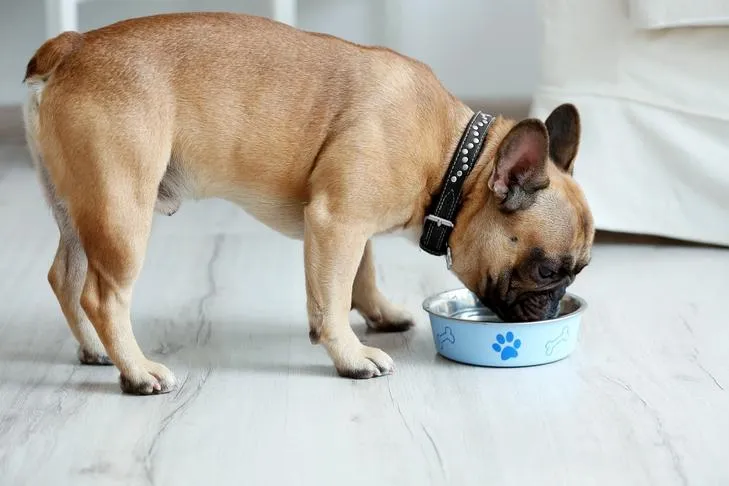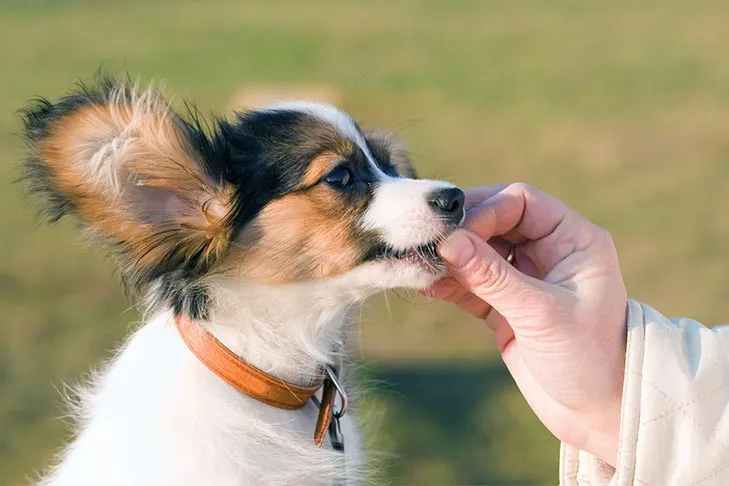As loving pet parents, it’s natural to wonder about sharing our meals with our furry companions. The question “What Is Okay To Feed Dogs” is one of the most common queries, as we strive to provide the best nutrition and occasional treats without risking their health. While commercial dog food provides complete and balanced nutrition, many human foods can be safe and even beneficial additions to your dog’s diet when given in moderation and prepared correctly. However, it’s crucial to understand which foods are safe, how to prepare them, and which ones to strictly avoid. Just like humans, every dog is an individual, and what works for one might not work for another. Always consult your veterinarian before introducing new foods, especially if your dog has allergies or a sensitive digestive system. Understanding the dos and don’ts can help you make informed choices, ensuring your canine friend enjoys a healthy and happy life. Can dogs eat what humans eat is a complex question with many nuances, and this guide aims to clarify some common dilemmas.
General Guidelines for Feeding Human Foods to Dogs
Before diving into specific foods, remember these overarching principles:
- Moderation is Key: Even healthy human foods should only be given as occasional treats, not as a primary food source. They should not exceed 10% of your dog’s daily caloric intake to prevent nutritional imbalances or weight gain.
- Plain and Unseasoned: Always offer foods that are plain, cooked, and completely unseasoned. Avoid salt, sugar, spices, onions, garlic, and artificial sweeteners, as these can be toxic or harmful to dogs.
- Proper Preparation: Remove all bones, seeds, pits, and skins that could pose choking hazards or contain toxic compounds. Cook raw meats and eggs thoroughly to eliminate bacteria like salmonella.
- Monitor for Reactions: Introduce new foods slowly and in small quantities. Observe your dog for any signs of digestive upset, allergies, or unusual behavior.
- Consult Your Vet: When in doubt, always speak with your veterinarian. They can provide personalized advice based on your dog’s breed, age, size, and existing health conditions.
Safe Human Foods for Dogs
Here’s a detailed look at human foods that are generally safe for dogs, along with their benefits and important considerations:
Bread
Small amounts of plain, unseasoned bread are typically safe for dogs as an occasional treat. While it offers little nutritional value, it’s unlikely to cause harm unless it contains toxic ingredients like raisins or xylitol. Homemade whole-wheat bread without preservatives is generally a better option than store-bought varieties. However, given its high carbohydrate and calorie content, bread should be offered sparingly to avoid weight gain, which can lead to other health issues. It’s truly a filler food with minimal benefits for canine health.
Cashews
Cashews can be given to dogs in very small quantities. These nuts contain beneficial nutrients like calcium, magnesium, antioxidants, and protein, which contribute to overall health. However, cashews are also high in fat, and consuming too many can lead to weight gain or digestive upset like pancreatitis, especially in sensitive dogs. Always offer only plain, unsalted, roasted cashews, as salt can be detrimental to a dog’s health. A few cashews can be a nice, crunchy reward.
Cheese
Many dogs enjoy cheese, and it can be a good treat in moderation, provided your dog is not lactose intolerant. While actual lactose intolerance in dogs is relatively rare compared to humans, some dogs may have difficulty digesting dairy. Cheese is a source of protein and calcium. Opt for lower-fat varieties like cottage cheese, mozzarella, or goat cheese to reduce the risk of excessive fat intake and potential weight issues. Always avoid cheeses with added herbs, garlic, or onions. Hard, dog-specific cheese chews, like those made from Himalayan yak milk, are also popular and safe options.
 Curious dog looking at a block of cheese on a kitchen table, considering safe human foods for dogs
Curious dog looking at a block of cheese on a kitchen table, considering safe human foods for dogs
Coconut
Coconut, in its various forms, offers several health benefits for dogs. It contains lauric acid, known for its anti-bacterial and anti-viral properties, potentially boosting the immune system. Some owners find it helps with bad breath and improves skin conditions such as hot spots, flea allergies, and dry, itchy skin. Plain coconut meat, coconut milk, and coconut oil are generally safe. When offering fresh coconut, ensure the hard, fibrous outer shell is removed entirely, as it can be a choking hazard or cause intestinal blockage if ingested. As with any high-fat food, offer coconut in moderation.
Corn
Corn is a common ingredient in many commercial dog foods, serving as a source of carbohydrates, fiber, and protein. As such, plain, cooked corn kernels are safe for dogs. However, the corn cob itself is indigestible and can cause a serious intestinal blockage, which often requires surgical intervention. If you’re sharing corn, always make sure it’s completely off the cob. Plain, boiled, or steamed corn, without butter or salt, can be a sweet and crunchy treat. For dogs who love to chew, a squeaky corn-shaped toy might be a safer alternative.
Eggs
Fully cooked eggs are an excellent source of high-quality protein, vitamins (A, B12, D, E), and essential amino acids, making them a nutritious addition to a dog’s diet. They can be particularly helpful for dogs with an upset stomach due to their digestibility. It’s crucial that eggs are cooked thoroughly – boiled, scrambled, or poached without any added fats, salt, or seasonings. Raw egg whites contain avidin, an enzyme that can interfere with biotin absorption, potentially leading to a biotin deficiency over time. Cooking neutralizes avidin, making eggs perfectly safe and beneficial.
Fish
Certain types of cooked fish can provide a significant health boost for dogs due to their omega-3 fatty acids, quality protein, and essential vitamins and minerals. Salmon and sardines are particularly beneficial. Salmon is rich in omega-3s, which support brain function, joint health, and a healthy coat, while sardines offer calcium due to their soft, digestible bones. Always ensure fish is fully cooked and all tiny bones are meticulously removed (except for the soft bones in sardines). Never feed raw or undercooked fish, as it can contain parasites that are highly toxic to dogs and can cause severe illness or even death. Limit fish intake to once or twice a week to avoid mercury accumulation.
Ham
While a small, plain piece of ham might not immediately harm your dog, it’s certainly not the healthiest option. Ham is typically high in sodium and fat, which can contribute to excessive thirst, digestive issues, and even pancreatitis if consumed in large quantities regularly. While sharing a tiny, unseasoned bit occasionally is generally acceptable, it should not become a regular habit. Avoid any ham with glazes, spices, or bones, as these pose additional risks.
 French Bulldog happily eating from a food bowl, demonstrating proper dog feeding
French Bulldog happily eating from a food bowl, demonstrating proper dog feeding
Honey
Honey is packed with a multitude of nutrients, including various vitamins (like A, B complex, C, D, E, K), minerals (potassium, calcium, magnesium, copper), and powerful antioxidants. For some dogs, small amounts of local, raw honey can help alleviate seasonal allergies by introducing trace amounts of pollen, thereby building immunity. Beyond consumption, raw honey also possesses natural antibacterial and anti-inflammatory properties, making it useful as a topical treatment for minor burns or superficial cuts, promoting healing. However, due to its high sugar content, it should be given sparingly.
Milk
Dogs can drink milk, but caution is advised. While puppies depend on their mother’s milk, many adult dogs become lactose intolerant, meaning they lack the enzyme needed to properly digest lactose, the sugar in milk. This can lead to digestive upset, including diarrhea, gas, and stomach pain. If you offer a small amount of plain cow’s or goat’s milk, observe your dog closely for any adverse reactions. Most veterinarians recommend sticking to water as the primary beverage.
Peanut Butter
Plain, unsalted peanut butter can be an excellent source of protein, healthy fats, vitamins B and E, and niacin for dogs. It’s often used to hide medication or as a high-value treat during training. However, it’s imperative to read the label carefully to ensure it does not contain xylitol, a sugar substitute that is highly toxic and potentially fatal to dogs. Opt for raw, unsalted varieties with minimal ingredients. Even safe peanut butter is calorie-dense, so moderation is crucial to prevent weight gain.
Peanuts
Unlike some other nuts that are toxic to dogs (e.g., macadamia nuts), plain peanuts are safe for canine consumption. They are rich in healthy fats and proteins that can contribute to your dog’s overall well-being. However, similar to peanut butter, peanuts are high in fat, so they should be offered in strict moderation to prevent gastrointestinal upset or the development of pancreatitis. Always ensure they are unsalted and roasted, avoiding any candied or flavored varieties.
Popcorn
Unsalted, unbuttered, and air-popped popcorn can be an acceptable snack for your dog in moderation. It contains riboflavin and thiamine, which support eye health and digestion, along with small amounts of iron and protein. The key is its plain preparation. Ensure all kernels are fully popped, as unpopped kernels can pose a serious choking hazard or become lodged in teeth. Avoid microwave popcorn due to added chemicals, salt, and butter.
Pork
Pork is a highly digestible protein source, rich in amino acids essential for muscle development and overall health. For some dogs with sensitivities to other proteins like chicken or beef, pork can be a good alternative. It’s generally less likely to cause an allergic reaction. When offering pork, ensure it is thoroughly cooked, plain, and all excess fat and skin have been removed. Never give your dog raw pork, as it can contain parasites that cause trichinosis. Also, avoid highly processed pork products like bacon or sausage due to their high salt and fat content.
Quinoa
Quinoa is a pseudocereal that has gained popularity in human diets and is now found in some high-quality dry dog foods. Its robust nutritional profile makes it a healthy alternative to common grain fillers like corn, wheat, and soy. Quinoa is a complete protein, meaning it contains all nine essential amino acids, and is also rich in fiber, vitamins, and minerals. When cooked and served plain, without any seasonings, it can be a nutritious and easily digestible addition to your dog’s meal. For pet owners concerned about what vegetables can my puppy eat safely, plain cooked quinoa can also be a good, digestible option.
 Fluffy white Samoyed puppy relaxing outdoors in green grass, representing a healthy and well-cared for pet
Fluffy white Samoyed puppy relaxing outdoors in green grass, representing a healthy and well-cared for pet
Salmon
As highlighted earlier, fully cooked salmon is an outstanding source of protein, essential fats (omega-3s), and amino acids. These nutrients play a vital role in promoting joint health, supporting cognitive function, and boosting the immune system. However, the distinction between cooked and raw salmon is critical. Raw or undercooked salmon can harbor parasites, particularly the Neorickettsia helminthoeca fluke, which causes “salmon poisoning disease.” This condition can be fatal if not treated promptly, leading to severe vomiting, diarrhea, dehydration, and lethargy. Always cook salmon thoroughly to kill these parasites, and then allow it to cool before serving small, boneless pieces to your dog.
Shrimp
A few cooked shrimp can be a delightful and healthy treat for your dog now and then. Shrimp are low in fat, calories, and carbohydrates, while being rich in antioxidants, vitamin B-12, and phosphorus. These nutrients support energy metabolism and bone health. It is absolutely essential to ensure shrimp are fully cooked and that the entire shell, including the tail, head, and legs, is completely removed before offering. Raw shrimp can contain harmful bacteria, and shells pose a significant choking hazard or can cause internal irritation.
Tuna
Cooked, fresh tuna, given in moderation, is an excellent source of omega-3 fatty acids, which are beneficial for heart and eye health. However, canned tuna presents a few more considerations. It typically contains higher levels of sodium and small amounts of mercury, which can accumulate in a dog’s system over time if consumed frequently. If offering canned tuna, choose varieties packed in water (not oil) and without any added spices. A small amount of plain canned tuna or tuna juice occasionally is generally fine, but it should not be a regular part of their diet.
Turkey
Plain, cooked turkey is generally safe for dogs and is often found in commercial dog foods due to its high protein content. When feeding turkey, it’s crucial to remove all excess fat and skin, as these can be difficult to digest and contribute to pancreatitis. Most importantly, ensure all bones are removed. Poultry bones can splinter easily when chewed or digested, leading to choking, internal blockages, or even perforation of the intestines, which is a life-threatening emergency. Always serve unseasoned, thoroughly cooked turkey without any onions, garlic, or excessive salt.
Wheat or Grains
Contrary to popular belief, most dogs do not need to be on a grain-free diet. Grains like wheat, corn, rice, and oats are valuable sources of essential fatty acids, fiber, and protein. They provide energy and can aid in healthy digestion. Unless your dog has a diagnosed allergy or specific sensitivity to grains (which is relatively uncommon compared to protein allergies), there’s no inherent reason to avoid them. In fact, many high-quality dog foods include grains. If you suspect your dog has food allergies, consult your veterinarian to determine the best dietary recommendations. For a broader understanding of various dietary considerations, exploring topics like what vegetables not to give dogs can also be very helpful.
Yogurt
Plain, unsweetened yogurt can be a perfectly acceptable and beneficial snack for dogs. It contains active bacteria cultures (probiotics) that can help strengthen the digestive system and improve gut health. Opt for plain, low-fat yogurt without any added sugars, artificial sweeteners (especially xylitol), or fruit flavorings, as these can be harmful. While many dogs can tolerate yogurt, some may have difficulty digesting dairy products. Introduce it slowly and in small amounts to see how your dog reacts.
 Small Papillon puppy gently taking a healthy treat from a human hand, illustrating responsible pet feeding
Small Papillon puppy gently taking a healthy treat from a human hand, illustrating responsible pet feeding
Human Foods Dogs Can’t Eat: A Quick Reminder
While this article focuses on what is okay to feed dogs, it is equally, if not more, important to be aware of the foods that are dangerous or toxic to them. Certain human foods can cause serious illness, organ damage, or even death. Always keep these foods away from your dog:
- Chocolate (contains theobromine)
- Grapes and Raisins (can cause kidney failure)
- Xylitol (a sugar substitute found in many sugar-free products, extremely toxic)
- Onions, Garlic, Chives, Leeks (can cause red blood cell damage)
- Avocado (persin can cause vomiting and diarrhea)
- Alcohol (toxic, even in small amounts)
- Caffeine (stimulant, can be fatal)
- Macadamia Nuts (can cause weakness, vomiting, tremors)
- Cooked Bones (splinter and cause internal damage)
- Fatty Trimmings and Gravy (can cause pancreatitis)
- Yeast Dough (can rise in stomach, producing alcohol)
- Salt (can cause sodium ion poisoning)
For a comprehensive guide on dangerous foods, always refer to expert advice on what should dogs not be fed. If you suspect your dog has ingested something toxic, contact your veterinarian or an animal poison control center immediately.
Conclusion
Understanding what is okay to feed dogs from your own kitchen can be a rewarding part of responsible pet ownership. By offering safe human foods in moderation, properly prepared, and free from harmful additives, you can provide your canine companion with occasional healthy treats that complement their balanced diet. Always prioritize your dog’s health and safety, remembering that their digestive systems differ significantly from ours. When in doubt, err on the side of caution and consult with your veterinarian. They are your best resource for tailored dietary advice to ensure your dog thrives. Continue exploring our website for more expert tips and stories on comprehensive dog care.
